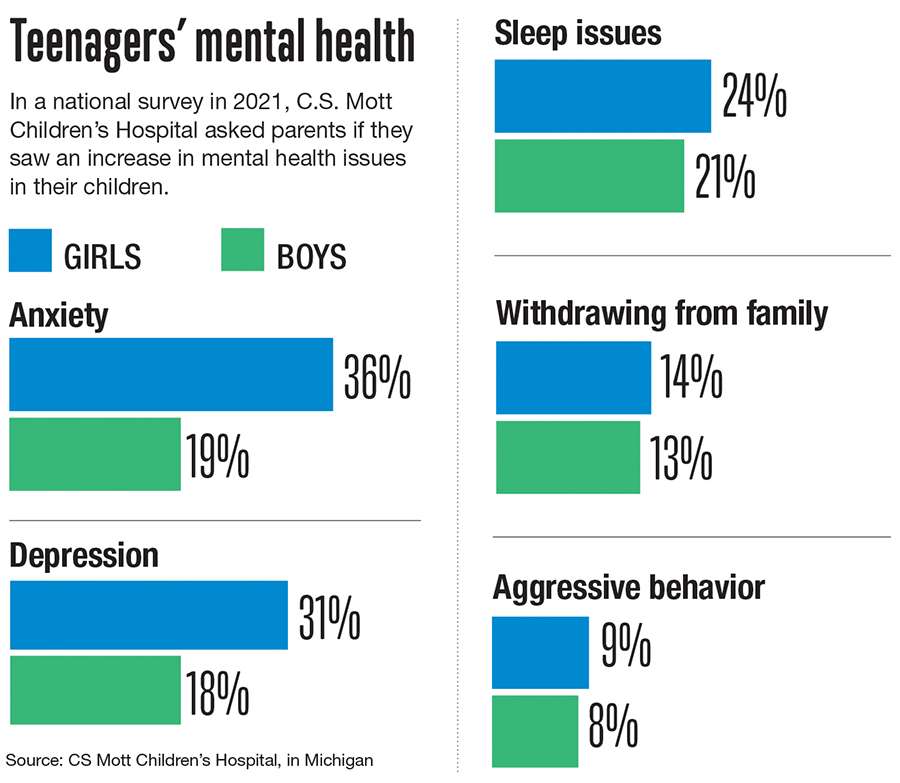
The pandemic’s lasting impact on mental health
 IMAGE/ADOBE STOCK.COM
IMAGE/ADOBE STOCK.COM
The COVID-19 pandemic has affected people’s mental wellbeing in complex, interconnected ways, from the loss of loved ones to isolation and disrupted routines.
In April of 2020, 45% of American adults reported the pandemic was harming their mental health, according to a Kaiser Family Foundation survey. And that number remained fairly steady over the year that followed.
Today, many aspects of life are getting closer to the pre-pandemic norm, but there’s still a long way to go to recover mentally from what people have been through.

“This is our surge,” said Lori Simkowitz-Lavigne, vice president of children’s services for Worcester-based Community Healthlink Inc. “We are experiencing a surge of people calling for services for their children.”
Young children & the elderly suffer
Simkowitz-Lavigne said she and her colleagues were active throughout the height of the pandemic, meeting with kids and families outdoors at their homes and doing telehealth appointments. But, she said, today calls are at an even higher volume. Part of that is due to more children returning to school, where professionals may notice symptoms of psychological distress.
“Now the floodgates are open as teachers and support staff have contact with them,” Simkowitz-Lavigne said.
She said it will probably take a while to get a grip on the problems children have been facing, partly because they may have compounded while they went untreated. Meanwhile, a shortage remains for inpatient psychiatric slots for children with severe mental health problems, particularly as healthcare facilities have closed beds to allow for social distancing or address COVID outbreaks.
This situation adds to a crisis Simkowitz-Lavigne said already existed before COVID – a lack of sufficient clinicians and paraprofessionals to serve families and young people.

There’s a similar problem on the other end of the age spectrum, said Denise Tufts of Grace Aging Services LLC, which provides counselling to older adults in Central Massachusetts. She said the shortage of home care aides, nursing home staff and nurses was a problem before the pandemic. And, when COVID struck, many workers were unable to continue visiting clients’ homes.
“During this time, it was really stressful,” Tufts said. “Many of my clients did not have an aide.”
In general, she said, older people were cut off from social contact. Family members and friends were often unable to visit, and public gathering places were closed. Tufts said that eliminated many of the usual options for fighting isolation and declining mental health.

“I used to be able to say ‘Why not try the senior center or volunteering at the hospital?’” Tufts said. “We didn’t have those strategies. They were limited to what they could do at their house.”
Unlike younger people, she said, her clients don’t use the internet to socialize.
Now that people, particularly a majority of those over 65, have been vaccinated, Tufts said things are looking up for her clients, but some are still fearful. Others express worries about the way they see the country changing. It doesn’t help, she said, for those who rely on television news channels to keep them company.
“I try to tell them, ‘Sometimes the news, they make it worse than it is,’” she said. “I really try to encourage them to limit their news watching, like we encourage children to limit social media.”
On the other hand, she said one bright spot during the pandemic has been more media attention to mental health, which may reduce the stigma around seeking help.
Finding the right support
Like senior centers, peer support groups have had to pause their activities due to COVID. Catherine Gaudet, president of the National Alliance on Mental Illness in North Central Massachusetts, said the support groups are still using Zoom.

“A lot of people don’t want to go because it’s not face to face, she said. “It’s just not the same on Zoom.”
She said the groups normally meet at local hospitals, which are not yet allowed to have indoor gatherings.
“And when they are, we have to figure out how to do the six-foot distancing, and mask-wearing,” she said.
Gaudet said being firm about social distancing makes good sense, since people who make use of the groups have comorbid conditions making them vulnerable to illness.
“I understand, but at the same time, like everyone else, I am frustrated because I see the need,” she said.

Elizabeth Louder, Community Healthlink vice president for acute care, who oversees the substance use division, said isolation and high unemployment contributed to increased levels of substance use disorders during the pandemic, while making it harder for people to seek help.
With pressures related to the pandemic easing, Louder said she feels hopeful about the future. The pandemic has helped Healthlink find new ways to reach clients, including innovative uses of telemedicine, which will remain part of its toolkit.
However, she said the effects of the pandemic won’t disappear overnight.
“What we’re seeing now is a real fatigue,” she said. “It’s not just that they were isolated. It’s that they’re exhausted from this, 15, 16 months later.”









0 Comments